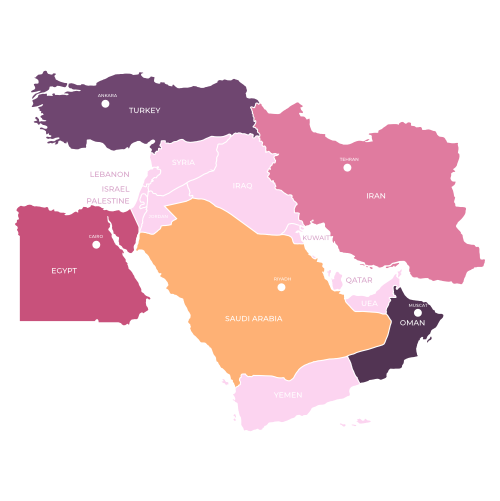
Asthma in the Middle East – What’s the State of Play?
The below content is derived from research done using sources available on the internet. Safey Medical Devices Inc and its subsidiaries do not take any responsibility for the accuracy of the content. No medical decision should be taken on the basis of below content without consulting with your Medical Practitioner.
Asthma control among adult sufferers is deemed unsatisfactory and asthma rates among children have increased. Discover the state of asthma in the Middle East.
The Gulf states are experiencing an asthma epidemic, with many countries throughout the Middle East reporting a rise in the number of asthma sufferers in adult and children.
Levels of asthma control are said to be disappointingly low in many parts of the world and the Middle East and North Africa are two areas where this is a growing issue.
Why is this the case and why are young Middle Eastern children becoming increasingly susceptible to asthma symptoms? This systematic assessment of the state of play of Asthma in the Middle East shines a spotlight on the pressing concerns of lung health in the Gulf.
Are rapidly changing Middle Eastern lifestyles to blame?
In 2013, research overseen by Mohammed Al Ghobain, a pulmonologist at the King Saud bin Abdulaziz University for Health Sciences in Riyadh, found that almost a quarter (24%) of residents in Saudi Arabia suffered from asthma.
Although the World Health Organisation (WHO) is unable to define the specific cause of asthma prevalence in the Middle East, many medical experts in the Gulf states attribute the rapid urbanisation of towns and cities as an influential factor.
Mr Al Ghobain believes the exceptionally high rates of asthma in Saudi Arabia are caused by increasingly crowded urban environments, 21st century changes in lifestyle i.e. dietary habits and increased exposure to indoor allergens, tobacco smoke, dust particles and sandstorms.
One-in-six UAE residents are asthma sufferers
Allergens such as dust mites and high levels of humidity are also said to be triggering asthma symptoms among residents in the United Arab Emirates. One-in-sixresidents in the UAE suffer with asthma symptoms.
Dr Mohammad Rafique, medical director, Prime Hospital, said that “when the humidity goes high and allergens like dust mites and air conditioning ducts aren’t maintained, then they could trigger asthma [in the UAE]”.
There have also been claims of pollen from date plants acting as a trigger for asthma symptoms. Meanwhile the advent of cockroaches within a home can also be a sure-fire sign of a property that will encourage the onset of asthma among adults and children alike.
More worryingly, the report linked above warns that doctors in the Middle East are failing to properly diagnose asthma symptoms.
Dr Rafique believes there are concerns at both ends of the spectrum regarding asthma diagnoses. Firstly, Rafique claims that too often coughing or wheezing is automatically labelled as asthma, resulting in “an over diagnosis”. Secondly, he believes there is a chronic under-reporting of some patients who fail to recognise when an asthma sufferer’s cough is more than just a tickle.
Asthma death rates across the Middle East
Which countries have the worst asthma-linked death rates in the Middle East? According to figures from the WHO in 2017, Yemen has the most alarming asthma death rates with 12.34 deaths per 100,000 linked to asthma. That’s followed by Syria (11.39 deaths), Morocco (9.65 deaths) and Iran (8.11 deaths).
At the other end of the spectrum, Qatar has comparably ‘good’ asthma death rates with just 0.62 deaths per 100,000 linked to asthma.
Less than a third of asthma patients in the Middle East control their symptoms
Earlier this year, a large-scale cross-sectional epidemiological study of asthma in adults was conducted across the Middle East and North Africa. The study assessed individuals that had been suffering with their asthma symptoms for at least one year but had not suffered an asthma attack within the last four weeks.
The objective of the study was to ascertain the link between the level of asthma control and adherence to quality of life and disease characteristics.
Of the 7,236 adults included in the survey, it was deemed that less than a third (29%) of asthma patients controlled their symptoms adequately. The outcome highlights the glaring need to provide better access to anti-asthma medication for suffers and better education regarding the adherence of medication among patients.
Furthermore, it also places greater emphasis on general practitioners and asthma nurses to provide better follow-up appointments and education during review sessions to ensure long-term benefits for their patients.
The worrying prevalence of asthma in Middle Eastern children
The prevalence of asthma and the allergies linked to asthma have increased significantly during the last couple of decades, not least in Middle Eastern children. A recent medical review of more than 50 studies into asthma and airborne allergies in children under 18 in the Middle East was undertaken.
More than a quarter-of-a-million children was examined in the studies, where it was found that asthma was affecting boys more than girls. Some 6.3% of girls suffered from asthma symptoms compared with 8.91% of boys surveyed.
Asthma in children is now one of the primary reasons for school absenteeism. Although many asthmatics diagnosed in their childhood will experience an improvement in their symptoms within two years of continued inhaler treatment, asthma attacks can still be prevalent into adult age.
The importance of inhaler adherence in the Middle East
In order to minimize exacerbations of asthma symptoms in the Middle East, asthma patients need to be better educated on the importance of inhaler adherence. The consumption of inhaled corticosteroids and bronchodilators is an important factor in the long-term easing of asthma symptoms and allowing adults and children alike to enjoy an improved quality of life.
Inhaler adherence is not only life-saving for patients, it is cost-saving for national economies and healthcare systems too.
At Safey, we’re firm believers in our industry-leading smart inhaler technology, designed to revolutionize the efficiency of medication adherence among asthma sufferers worldwide.
Our Bluetooth-enabled inhalers can ‘gamify’ a patient’s inhaler experience, helping them to improve their inhaler technique and communicate with caretakers and clinicians, who can take day-by-day data to monitor adherence and ensure patients’ lungs are receiving the crucial medicine they need to improve the airways.









